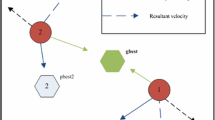Abstract
Feature selection is one of the most key problems in the field of machine learning and data mining. It can be done in mainly two different ways, namely, filter approach and wrapper approach. Filter approach is independent of underlying classifier logic and relatively less costly than the wrapper approach which is classifier dependent. Many researchers have applied Genetic algorithm (GA) as wrapper approach for feature selection. In the paper, a novel feature selection method is proposed based on the multi-objective genetic algorithm which is applied on population generated by non-linear uniform hybrid cellular automata. The fitness functions are defined one using set lower bound approximation of rough set theory and the other using Kullbak-Leibler divergence method. A comparative study between proposed method and some leading feature selection methods are given using some popular microarray cancer dataset to demonstrate the effectiveness of the method.
Access this chapter
Tax calculation will be finalised at checkout
Purchases are for personal use only
Preview
Unable to display preview. Download preview PDF.
Similar content being viewed by others
References
Yu, L., Liu, H.: Efficient feature selection via analysis of relevance and redundancy. The Journal of Machine Learning Research 5, 1205–1224 (2004)
Hall, M.A.: Correlation-based feature selection for machine learning. Diss., The University of Waikato (1999)
Goldberg, D.E., Holland, J.H.: Genetic algorithms and machine learning. Machine Learning 3(2), 95–99 (1988)
Deb, K., et al.: A fast and elitist multiobjective genetic algorithm: NSGA-II. IEEE Transactions on Evolutionary Computation 6(2), 182–197 (2002)
Schwefel, P.H.: Evolution and optimum seeking: the sixth generation. John Wiley & Sons, Inc. (1993)
Coello Coello, A.C., Lamont, B.G., Van Veldhuisen, D.A.: Evolutionary algorithms for solving multi-objective problems. Springer (2007)
Multi-objective Evolutionary Algorithms: A Survey of the State-of-the-art. Swarm and Evolutionary Computation 1(1), 32–49 (2011)
Zhou, A., Suganthan, P.N., Zhang, Q.: Decomposition Based Multiobjective Evolutionary Algorithm with an Ensemble of Neighborhood Sizes. IEEE Trans. on Evolutionary Computation 16(3), 442–446 (2012)
Knowles, J.D., Corne, D.W.: M-PAES: A memetic algorithm for multi-objective optimization. In: Proceedings of the 2000 Congress on Evolutionary Computation, vol. 1. IEEE (2000)
Zitzler, E., Lothar, T.: Multiobjective evolutionary algorithms: A comparative case study and the strength pareto approach. IEEE Transactions on Evolutionary Computation 3(4), 257–271 (1999)
Van Veldhuisen, D.A., Lamont, G.B.: Multi-objective evolutionary algorithm research: A history and analysis. Technical Report TR-98-03, Department of Electrical and Computer Engineering, Graduate School of Engineering, Air Force Institute of Technology, Wright-Patterson AFB, Ohio (1998)
Mumford, C.L.: Simple population replacement strategies for a steady-state multi-objective evolutionary algorithm. In: Deb, K., Tari, Z. (eds.) GECCO 2004. LNCS, vol. 3102, pp. 1389–1400. Springer, Heidelberg (2004)
Deb, K.: Multi-objective optimization. In: Multi-objective Optimization Using Evolutionary Algorithms, pp. 13–46 (2001)
Kullback, S., Leibler, R.A.: On Information and Sufficiency. Annals of Mathematical Statistics 22(1), 79–86 (1951), doi:10.1214/aoms/1177729694
Chaconas, G., Lavoie, B.D., Watson, M.A.: DNA transposition: jumping gene machine, some assembly required. Current Biology: CB 6(7), 817 (1996)
Von Neumann, J.: Theory of self-reproducing automata (1966)
Pawlak, Z.: Rough set approach to knowledge-based decision support. European Journal of Operational Research 99(1), 48–57 (1997)
Turing, A.: Universal Turing machine
Cover, T., et al.: Elements of information theory. Telecommunications, Wiley series (1991)
Hall, M., Frank, E., Holmes, G., Pfahringer, B., Reutemann, P., Witten, I.H.: The WEKA Data Mining Software: An Update. SIGKDD Explorations 11(1) (2009)
Author information
Authors and Affiliations
Editor information
Editors and Affiliations
Rights and permissions
Copyright information
© 2013 Springer International Publishing Switzerland
About this paper
Cite this paper
Pati, S.K., Das, A.K., Ghosh, A. (2013). Gene Selection Using Multi-objective Genetic Algorithm Integrating Cellular Automata and Rough Set Theory. In: Panigrahi, B.K., Suganthan, P.N., Das, S., Dash, S.S. (eds) Swarm, Evolutionary, and Memetic Computing. SEMCCO 2013. Lecture Notes in Computer Science, vol 8298. Springer, Cham. https://doi.org/10.1007/978-3-319-03756-1_13
Download citation
DOI: https://doi.org/10.1007/978-3-319-03756-1_13
Publisher Name: Springer, Cham
Print ISBN: 978-3-319-03755-4
Online ISBN: 978-3-319-03756-1
eBook Packages: Computer ScienceComputer Science (R0)




